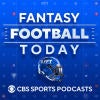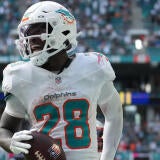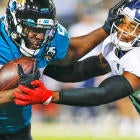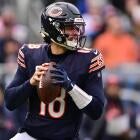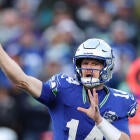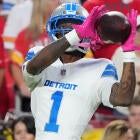Stealing Signals: AFC South 2019 recap, what to expect heading toward 2020
Ben Gretch reviews the 2019 season for each team from the AFC South.
With the 2019 regular season in the books, I'll be going division by division to share my initial offseason takeaways from each team.
This is mostly postseason note-taking as I emphasize what stands out most from the Stealing Signals column in 2019. We have an entire offseason of coaching and personnel changes plus additional research to break down what our 2020 Fantasy expectations will be, but I intend to refer back to these pieces as a barometer of sorts.
Houston Texans
Snap Notes: Carlos Hyde/Duke Johnson — traditional early/passing downs tandem with snaps dependent on game script; Will Fuller — sub-30% in two games (left with injury), full-time otherwise; Darren Fells/Jordan Akins — both averaged over 60% (lot of two-TE sets)
Key Stat: DeAndre Hopkins — 10.5 aDOT (1.4 yards lower than previous career low)
Houston's offense was average to above average pretty much across the board in 2019, with solid efficiency both rushing and passing the ball. They probably ran a little too much at times, but a lot of teams do that, and their player roles were well defined and pretty easily explainable by the raw end-of-season stats.
Carlos Hyde was the early down back, which his 245 carries and 10 receptions indicate. He fit in well considering how he'd looked over the past few seasons across multiple teams, but the lack of receiving made him the lowest-scoring 1,000-yard rusher in PPR leagues at RB28.
Duke Johnson handled passing downs, rushing just 83 times all season but catching 44 balls. I thought Johnson gave the offense more versatility and many wished he'd get more work on all downs, but it's worth pointing out that on average Johnson faced fewer defenders in the box, which often happens with passing-downs backs. The number of defenders in the box has been shown to be a major factor in yards per carry, and it helps explain why the Texans continued to use Hyde in his role despite Johnson's superior YPC. Johnson has been very good throughout his career and continues to seem deserving of more work — something he got and showed he could handle in college — but probably the biggest reason that hasn't happened over the past couple of seasons is the teams he's been on have had another effective option.
The passing game flowed through DeAndre Hopkins and Will Fuller when the latter was healthy. Hopkins started slow, and the most notable part of his stat line was his aDOT was well below his career norms. At 10.5 for the season, Hopkins' average target was 1.4 yards shallower than his previous career low. That was a big reason for his career-low 7.8 yards per target and dip in touchdown rate, but he still posted a strong full-season line.
In Week 5 against Atlanta, Fuller had the only 50-point PPR Fantasy total of any player this season when he caught 14 balls for 217 yards and three scores. But that peak probably only added to the perception of him as boom-or-bust, as he had several down games, at times leaving points on the field like in Week 6 in Kansas City where he arguably dropped three touchdowns.
In fairness, two of Fuller's duds were the result of sub-30% snaps shares due to injury, and another was against New England where he had a long touchdown overturned on replay due to his foot being on the line. But the injuries are of course a big part of analyzing Fuller, as he hasn't played 16 games in any of his four seasons. While he's mostly been an effective deep threat and was a couple near-misses away from a much better 2019 when healthy, he'll be a risk-reward pick in 2020 drafts.
Kenny Stills came over in a preseason trade and played the WR3 role, filling in as a full-timer when Fuller was out. He didn't produce much in those games with big snap shares when Fantasy managers were using him most, but he did produce at other times and was probably better than perception. His end-of-season line featured a strong 10.2 yards per target.
Darren Fells and Jordan Akins each played solid snap shares throughout the season, and they split the passing work. Akins finished with more targets, receptions and yards, but Fells had seven touchdowns to Akins' two. After a high-touchdown rookie season, Jordan Thomas missed most of the season, and the team also drafted Kahale Warring in 2019. It's not clear who will be the lead tight ends heading into 2020, and even if it was, it seems likely the production will again be split up.
Deshaun Watson's full-season numbers were down a bit due to a few poor stat lines, but a lot of that lined up with poor protection. He had four games where he threw for fewer than 200 yards and zero touchdowns, while in all others he was above 200 yards with at least one passing score. In each of the four bad games, he was sacked at least four times. He's worthy of being a top Fantasy quarterback in 2020 drafts, and if Houston ever gets their protection issues figured out he could have a monster year.
Signal: DeAndre Hopkins — usage shifted toward more possession-receiver targets in 2019, perhaps capping upside
Noise: Will Fuller — weekly variance (multiple games leaving early, solid full-season numbers overall)
Indianapolis Colts
Snap Notes: T.Y. Hilton — full snap shares in only five early-season games (played in five more, missed six); Marlon Mack — sub-50% in 7 of 14 active games; Eric Ebron/Devin Funchess/Parris Campbell/Chester Rogers — all missed 3+ games
Key Stat: Zach Pascal — 607 receiving yards (no other team had a team leader with fewer)
After the August retirement of Andrew Luck, the Colts' skill position group was one of the most injured units in 2019, and the combination of those two factors made 2019 a rough season. Indianapolis went pretty run-heavy early in the year as they adjusted to Jacoby Brissett as their full-time starter, and they wound up with the fifth-most rush attempts in the league against the 24th-most pass attempts.
Entering 2019, the Colts under Frank Reich had previously been very reactive to game script when it came to run/pass splits and personnel usage, and that seemed to be the case this year as well. One example was Eric Ebron's snaps and routes spiking in a 12-target game in a loss to Miami, only for them to fall back to normal rates the next week in a big win over Jacksonville.
Marlon Mack seemed to have bucked that trend when he played at least 70% of the snaps in each of the first two games of the year, and hit 60% or more in six of the first seven. But after that point, he wouldn't hit 60% again, and while some of that was likely due to injury, his snaps did seem to trail off after the Colts' Week 6 bye up until he got hurt in Week 11.
A weird element of Mack's usage was that while he played in seven wins and seven losses, 13 of his 14 receptions came in wins, which goes against the norm. Nyheim Hines, the passing downs back, caught 3.1 passes per game in losses against 2.3 in wins. My theory there was that Mack really only had a passing role when the team led, he was in more because they were in run-first mode, and they passed in those spots occasionally to mix it up. The other side of that theory is they would just go to Hines when they were in obvious passing situations.
Regardless of the reason, Mack's 14 catches didn't help him post a strong Fantasy total, and he wasn't a difference-maker despite a strong rushing season with over 1,000 rushing yards and eight rushing scores. Mack rushed 247 times, while Jordan Wilkins and Jonathan Williams combined for another 100 carries behind him, both rushing effectively, and Hines added another 52 carries. Williams' carries mostly came while Mack and Wilkins were both hurt, but Wilkins seemed to cut into Mack's workload late in the year. There's enough competition and confusion about roles that I'm pessimistic about the whole backfield in 2020, despite the run-heavy lean.
T.Y. Hilton played partial snap shares in half of his 10 games, and after strong touchdown production early (when he was healthiest), he had a mostly lost season. While Hilton was healthy, he was the main Colt playing full-time snaps, as the team rotated several other pass-catchers. Add in that Devin Funchess, Ebron, Parris Campbell and Chester Rogers all experienced injuries, and there was little to take away.
The most consistent force in the passing game was Zach Pascal, who stepped up when Hilton initially missed time and maintained a key role throughout the remainder of the season. Though Pascal led the team in receiving, his team-leading 607 yards were 65th in the league, and no team's leader had fewer. We'll see what the offseason holds for the Colts, but 2020 is likely to look much different than 2019.
Signal: Marlon Mack — limited passing game usage, especially in losses
Noise: Team — high skill position injury rates, most of their offensive philosophy given they had to adjust on the fly a bit to not having Andrew Luck
Jacksonville Jaguars
Snap Notes: Leonard Fournette — 89% average snap share (second highest among RB to Christian McCaffrey)
Key Stat: Leonard Fournette — 341 touches, 3 touchdowns (first player since 2007 with 3 or fewer scores on that many touches)
Leonard Fournette was the poster guy for the right type of running back workload but poor efficiency. Fournette's 89% average snap share was second highest among the league's backs to only Christian McCaffrey, and he was well clear of Ezekiel Elliott's 84% in third place. He was a true three-down back who saw 100 targets and caught 76 balls, but he totaled just 522 receiving yards and no scores in the passing game on that work.
And despite clearly being the lead red zone back, Jacksonville's offense didn't create many scoring chances, and Fournette scored just three times on the ground. That made him the first player since Willie Parker and Thomas Jones in the 2007 season to have three or fewer touchdowns on over 330 touches, and makes him a solid bounceback candidate if he appears likely to maintain so much involvement in all phases.
Behind him, Ryquell Armstead was mostly solid despite a low YPC on just 35 carries. He showed off some receiving chops and will make for a good late-round option in 2020.
D.J. Chark was one of the young breakout receivers in 2019, and his production working with both quarterbacks the Jaguars used was promising. Chark is a former second-rounder with 4.34 speed at 6 feet 3 inches tall, and he used those physical tools to make his hay down the field. Per the airyards.com receiver profiler, Chark was much better than league average in most efficiency metrics on targets that traveled 20-plus yards downfield, while he was slightly below average at the shallower depths.
But Chark also saw plenty of underneath targets — his 11.3 aDOT wasn't far off from the 11.1 league average for all wide receivers, and certainly doesn't tell the story of him being just a deep threat. That helped him to 118 targets in 15 games — deep threats often struggle to break 100 — and should help stabilize his production if he experiences some efficiency regression on the downfield looks.
Chris Conley fit more into the deep threat only classification, with his 14.0 aDOT on 90 targets and boom or (mostly) bust profile, and Dede Westbrook was his direct opposite, with a 6.6 aDOT in a clear underneath role. Westbrook had his second straight 66-catch season but scored just three times, while Conley had a much higher yards per reception, going for more than 100 more yards than Westbrook on 19 fewer catches.
Interestingly, the two quarterbacks had divergent styles, with Nick Foles' average throw depth of 8.4 yards being much more vertical than rookie Gardner Minshew's 7.1. It will be interesting to see what Jacksonville does at quarterback, and as of now I'm optimistic about Chark and unsure about how to read the rest of the receiving corps, especially after the team chose to move on from offensive coordinator John DeFilippo.
That includes the tight ends, where athletic rookie Josh Oliver got some playing time for a brief stretch before getting injured, but struggled to earn meaningful targets. Four veteran tight ends combined for 68 targets with none seeing more than 20.
Signal: Leonard Fournette — every down role; D.J. Chark — established himself as the No. 1, was great down the field but not just a deep threat
Noise: Leonard Fournette — three touchdowns
Tennessee Titans
Snap Notes: A.J. Brown — rose throughout the season, first crested 90% in Week 10 (between 40%-50% in all four September games, around 60% through October, was full time after that)
Key Stat: Derrick Henry — 367 rush attempts through the divisional round (1,917 rushing yards, 5.2 YPC, 19 total touchdowns)
Derrick Henry defined the Titans' season, and I already wrote a longer deconstruction of his season. I do buy he's an outlier and expect that he'll continue to be an efficient runner, but after a playoff run that will likely push his draft cost into the first round in all formats — and his overall rush attempts for the year up to around 400 — I'll be unlikely to buy in. He's fantastic, but his PPR RB5 finish in 2019 is likely close to his ceiling without a substantial increase in passing work, and he's now failed to hit 20 catches in any of four seasons.
Ryan Tannehill and A.J. Brown were other defining players for an emergent late-season Titans' offense, and the duo thrived together after Tannehill took over as the starter in Week 7 and Brown started to play full time not long after. Brown totaled 778 receiving yards from that point on — more than the next two Titans, Corey Davis and Jonnu Smith combined — and 345 of those yards came after the catch.
I've been effusive in my praise of Brown, and he is to me easily the best talent to come out of an exceptionable 2019 wide receiver class. There have been several comps thrown around for Brown, but my favorite from a playing style is Terrell Owens. It's not often you see a 22-year-old wide receiver play with the physicality we saw from Brown in 2019. I expect great things from him throughout his career, in large part because he put up phenomenal age-adjusted production in college and he did that while sharing the field with D.K. Metcalf (and to a lesser extent Dawson Knox), whose production paled in comparison to Brown's. Now that we've seen positive returns not just from Brown but also from Brown's college teammates, his amateur production profile is that much more impressive.
And yet, this is a run-first offense, yards after the catch is a notoriously unstable stat and Brown struggled in some specific late matchups against upper echelon corners like Marshon Lattimore and Stephon Gillmore. There are some concerns, and Brown's early ADP is already sky high, so while I'm almost certain to buy in, it's looking like there will be much better values among a deep crop of young wide receivers in 2020 drafts. (Note to self: that doesn't necessarily mean Brown will be overvalued.)
Because I like Brown so much and still expect the Titans to lean on Henry, I'm unlikely to invest in their other wide receivers in 2020. Corey Davis just hasn't made good on his lofty draft status, and guys like Adam Humphries will struggle to see enough work.
But Jonnu Smith will be an interesting tight end option after impressive efficiency in an age-24 season that saw new Titans' offensive coordinator Arthur Smith feature him in a variety of ways, including tight end screens and even some rush attempts (he ripped off a 57-yard gain on a toss play in Week 15). The volume will be a concern, but Smith's arrow is pointing up.
Signal: A.J. Brown — college production carried over in a big way, very strong long-term outlook; Jonnu Smith — took a step forward, also a strong long-term outlook
Noise: Team — some degree of their late-season success, including ridiculous red zone scoring efficiency
